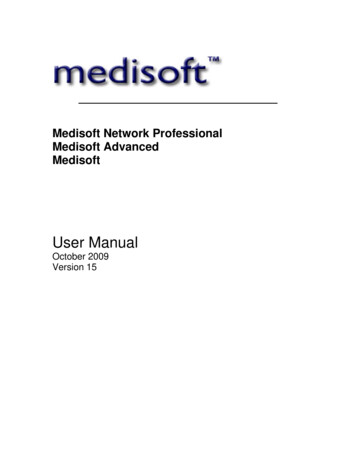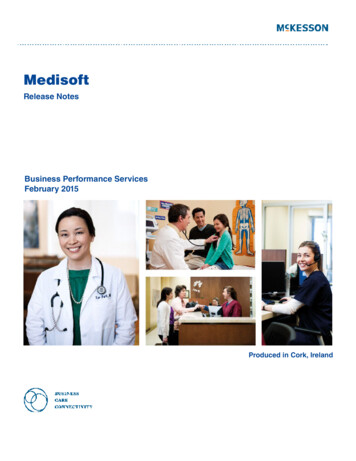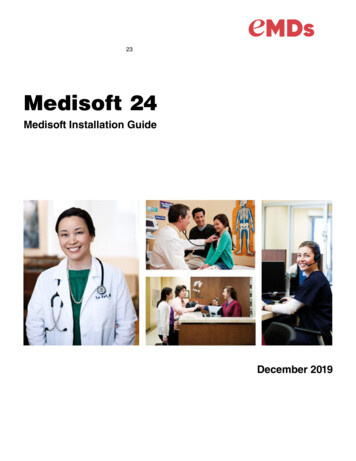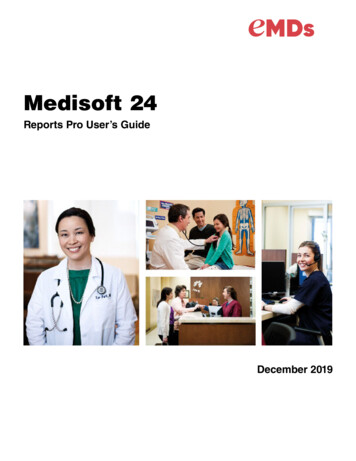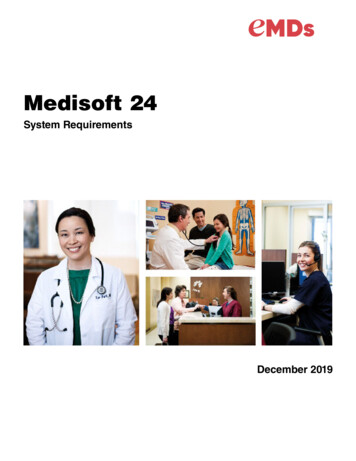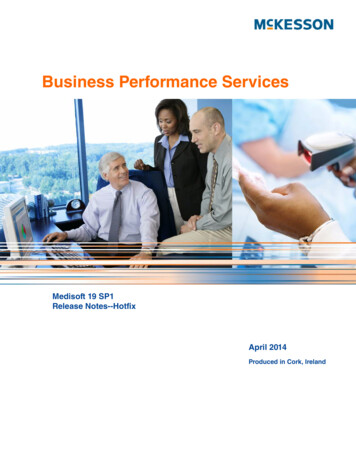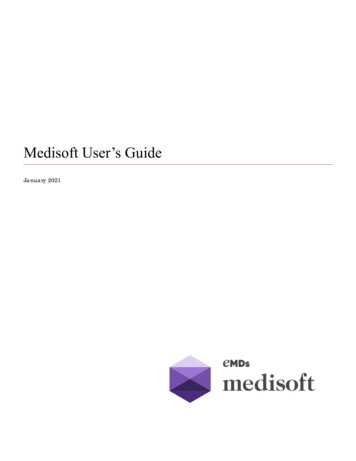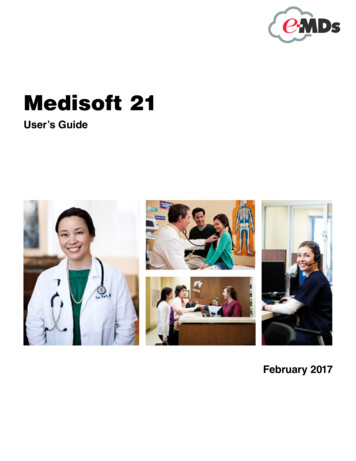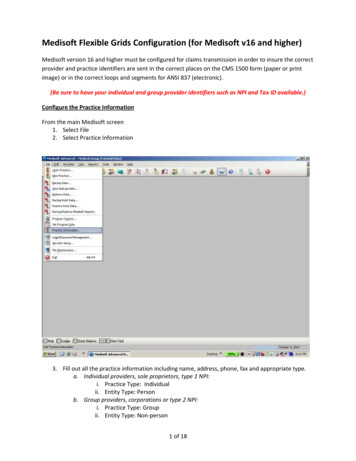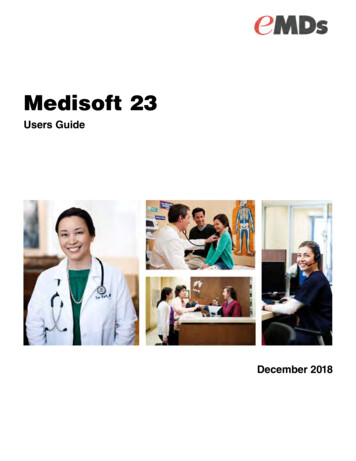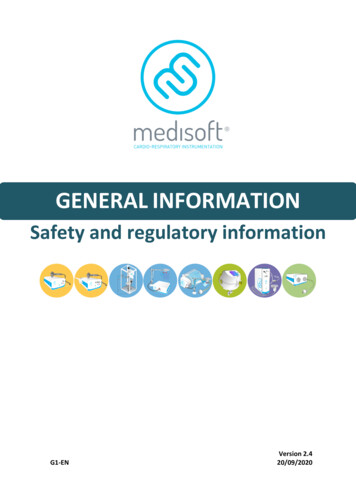
Transcription
GENERAL INFORMATIONSafety and regulatory informationG1-ENVersion 2.420/09/2020
Content1Foreword . 42Device identification. 53Warnings and EMC immunity . 643.1Essentials performances . 113.2Emission and immunity test levels . 123.2.1Emission. 123.2.2Immunity test levels . 12Contraindications for testing . 144.1Spirometry . 144.2Bronchial challenge testing . 164.2.1Absolute contraindications . 164.2.2Relative contraindications . 164.2.3Rational. 164.3Lung volumes measurement by Helium dilution . 174.4Lung diffusion measurement. 184.5Lung compliance measurement . 184.6Rhinomanometry . 184.7Other PFT techniques . 184.8Cardio-pulmonary exercise testing. 194.8.1Absolute contraindications . 194.8.2Relative contraindications . 195Accessory equipment . 206Environment . 217Fuses . 22G1-ENGeneral informationPAGE 2/23
.02.02.102/05/2019 2.212/12/2019 2.320/09/2020 2.4G1-ENModificationsCreationNew layout220V 60Hz version added.Portable RF communication equipmentEssentials performancesEnvironmentModification of the CE markingLabels correctionAdding Essentials performance and Emission and immunity test levelsGeneral informationPAGE 3/23
11 ForewordThank you for placing your trust and confidence in us by purchasing a MEDISOFT product.Since 1977 Medisoft develops, manufactures and provides a wide range of cardiopulmonarydiagnostic equipment. Medisoft has become a renewed and improved organization sinceAugust 2014. As part of the successful MGC Diagnostics group, a dedicated team is focusedon providing innovative cardiorespiratory health solutions.Medisoft proposes a wide range of products dedicated to cardiorespiratory systemdiagnostics. This range includes: Spirometry: Micro 6000, Micro 5000 Pulmonary function testing: BodyBox, SpiroAir, HypAir Cardiopulmonary exercise testing: Ergocard Endogenous Nitric Oxide measurement: FeNO Medisoft develops and provides also Expair software which allows performing calibrationsand exams on the devices manufactured by Medisoft, the storing of patient and exam data,and the design and printing of reports with exam results.This user manual aims to provide warnings, intended use and instructions for the correct useof the Medisoft equipment. Medisoft discourages the use of the product for any purposeother than those defined herein, and disclaims any liability arising from these other uses.Please read carefully this manual before any use of the equipment.Address of the manufacturerMedisoft S.A.P.A.E. de Sorinnes1, Route de la Voie Cuivrée5503 Dinant – SorinnesBelgium 32 82 22 30 20www.medisoft.beinfo@medisoft.beDeclaration of ConformityA copy of the Declaration of Conformity statement is available from your authorized salesrepresentative or Medisoft S.A. (info@medisoft.be).European Medical DirectiveThis device is compliant with the European Medical Directive 93/42/EEC and itslatest amendment 2007/47/EEC, and all the harmonized standards.G1-ENForewordPAGE 4/23
22 Device identificationAddress of the manufacturerKeep dryConsult the user manual before any use of the equipmentDo not put equipment or any part of the equipment (especially theelectrochemical cell) in a regular trashThe scraping of the equipment or any part of the equipment mustfollow the local lawThis device is compliant with the European Medical Directive 93/42/EECand its last amendment 2007/47/EEC, and all the collateral applicablestandardsType B applied partsType B equipment with a particular degree of protection against electricshock, particularly regarding allowable leakage currentsNominal power (in VA)Serial numberName of the deviceDate of manufacture (YYYY/MM)Power supply voltage and frequencyMain power inlet fuses (number x value)Attention: consult accompanying documentsRead user and service manual before any technical intervention on theequipmentG1-ENDevice identificationPAGE 5/23
Danger - indicates an imminently hazardous situation, which, if not avoided, will result indeath or serious injury.Warning - indicates a potentially hazardous situation, which, if not avoided, could result indeath or serious injury.Caution - indicates a potentially hazardous situation, which, if not avoided, may result inminor or moderate injury. It may also be used to alert against unsafe practices.The following section explains system warning and caution statements with respect to thesystem itself.Warning:To minimize the risk of electric shock, NEVER remove protective covers - this must bereferred to qualified service personnel. Dangerous voltages can be found within the case.Refer all service to trained and authorized service engineers. When working on “Live”powered systems to perform maintenance, correct and proper safety procedures mustbe followed.The FeNO is equipped with a Lithium Ion Battery for the is equipped with a lithium ionbattery to maintain the polarization of the analysis cell. Despite the low capacity of thisbattery (200mAh), the usual precautions must be taken when removing the device.Warning:Equipment is not suitable for use in the presence of a flammable anesthetic mixture withair, oxygen or nitrous oxide. Do not operate in an explosive atmosphere.Caution:When connecting external devices to the system, verify that the item being connected tothe system is compatible. Incompatible connections may damage the components.Caution:Ensure that the gas supply pressures are at the correct level. If gas pipe (tubing) isdamaged replace immediately. Never exceed recommended operating pressures. Makesure all gas connections are secure before turning on device and check regularly for leaksin gas lines or gas regulators. Never use oil based lubricants in the presence of 100%oxygen.Danger:DANGEROUS VOLTAGE – This symbol identifies a high voltage area that can produceelectric shocks. Do not remove cover while the system is turned on. All servicing shouldbe performed by qualified personnel.The use of the equipment must remain within the limits of its capacity and is reserved forcompetent operators. Users must have received appropriate training, provided byG1-ENWarnings and EMC immunityPAGE 6/2333 Warnings and EMC immunity
3Medisoft or by recognized trainers. Medisoft does not accept any responsibility formistakes and deviation from operating procedure to the instrument performed by theuser.Data security is the responsibility of the user, Medisoft does not accepts liability for dataloss. Backup is an essential requirement for the user of electronic stored data.Caution: In accordance with the EN 60601-1 Standard, these instruction for use are partof the equipment. The present directions for use must remain near the equipment.Absence of responsibility for indirect damage: Medisoft or its approved distributorscannot be held responsible for damages of any nature whatsoever (in particular physicalinjury, loss of income, work stoppages, loss of data and any other loss of a financialnature) resulting from the use or the impossibility of using the equipment and thesoftware especially when the user has been informed of the possibility of such damagesoccurring.With a view to constantly improving its products, Medisoft S.A. reserves the right tomodify the software or issue updates without prior notice. Therefore, some differencesmay exist between these directions for use and the version of the software actually inuse. An information note generally comes with the new versions of the software.However, if you experience difficulty, you can ask for a new copy of the directions foruse, corresponding to the version of the software installed on your equipment.After installation of the equipment, biological control testing should be performed onknown subjects to validate results and device operation. Biological control testing shouldbe repeated throughout the instrument’s life as a quality control. Non-biologicalcalibrators may be substituted where recommended or endorsed by the manufacturer.BodyBox, Ergocard, HypAir, SpiroAir, Micro 5000 & Micro 6000 are set for operation on230V/50Hz, 230V/60Hz or 115V/60Hz.FeNO device is set for operation on 100-240VAC 50/60Hz.Please consult the labels and manuals near the power switch for your local operatingcondition.All Medisoft’s devices are class 1 according IEC 60601-1 definitions and must be pluggedinto an earthed outlet. Main plug is considered as disconnecting accessory, make sure itis inserted into easily reachable mains socket outlet.The power supply fuses that are accessible from the outside of the device can only bereplaced, when blown, by a qualified technician recognized by Medisoft. The new fusemust strictly adhere to the original characteristics (values, type, and certification).WARNING: Portable RF communications equipment (including peripherals such asantenna cables and external antennas) should be used no closer than 30 cm (12 inches)to any part of the Medisoft’s devices (Micro 5000, Micro 6000, FeNO , Ergocard CPX,BodyBox, HypAir, SpiroAir ) including cables specified by the manufacturer. Otherwise,degradation of the performance of this equipment could result.G1-ENWarnings and EMC immunityPAGE 7/23
3The EMISSIONS characteristics of this equipment make it suitable for use in industrialareas and hospitals (CISPR 11 class A). If it is used in a residential environment (for whichCISPR 11 class B is normally required) this equipment might not offer adequateprotection to radio-frequency communication services. The user might need to takemitigation measures, such as relocating or re-orienting the equipment.All patient contact parts must be cleaned in accordance with the manufacturerrecommendations; typically hygienically cleaned with warm soapy water and disinfectedby cold sterilization methods.Care must be taken when handling parts that have come into contact with the patient.Gloves or other protective measures should be used in line with your local policy.Each distributor must provide after-sales service as well as the distributor’s personaldetails and phone number, which must be visible on the label on one of the devicepanels.Should the equipment receive an impact after being dropped, a sudden contact withanother object, or should it come into accidental contact with a liquid, it is strictlyforbidden to continue to use it before it undergoes a complete check by a serviceapproved by Medisoft.It is strictly forbidden to put any object into the ventilation holes.As the ExpAir program is used for both the PFT and dynamic spirometry devices, thescreen shots in these directions for use will not always correspond to those displayed onyour screen. Screen shots will depend upon the configuration and the various options ofyour equipment.The technical manual is only provided upon request and is reserved for qualifiedoperators approved by Medisoft.Unsatisfactory performance due to external causes is not warranted by Medisoft. Correctelectrical grounding of the instrument is essential for electrical safety.The environmental conditions described in paragraph 7 must be adhered to.Validation of the calibration of the pneumotachograph, pitot tube, volumetricspirometer and gas sensors should be performed daily and after cleaning anddisinfection.Do not operate the device in proximity to any equipment that has the potential togenerate a sufficiently large electromagnetic field (i.e. electric motor/MRI) as to interferein any manner with the operation of the device.The use of antibacterial filters is compulsory during testing on patients. These filtershave hydrostatic properties and prolonged use in a closed circuit may requirereplacement within a series of tests. The filters are SINGLE USE ONLY and must bereplaced with every new subject tested.G1-ENWarnings and EMC immunityPAGE 8/23
WARNING: Use of accessories, transducers, and cables other than those specified orprovided by the manufacturer of this equipment could result in increasedelectromagnetic emissions or decreased electromagnetic immunity of this equipmentand result in improper operation.If additional equipment is connected to the system, it is the end user's responsibility tohave the entire system, including added components, investigated per EN 60601-1.The system is not to be in the patient's vicinity when connected to other equipment notcompliant to EN 60601-1.Federal (US) law restricts this device to sale by or on the order of a physician.Cleaning - hygienic cleaning should be routinely performed using Sani surface wipes.Always ensure surfaces are dry after cleaning. Cleaning with hot water and multiplecleaning with high frequency could damage device.Please contact Medisoft S.A for more informationStorage - store the device in a dry place. Moisture in the device can adversely affectmeasurements.If the identification sticker becomes unreadable, please contact Medisoft S.A.This equipment should be validated regularly by biological control subjects or validatedcalibration devices recommended by the manufacturer. This forms a quality control ofthe instrument and should be available to the Medisoft engineer in case of failure orcomplaint. Medisoft recommends independent calibration certification bi-annually andnever longer than annually.The system components have been tested for electro-magnetic interference (EMI)/radiofrequency interference (RFI) compliance, and comply with the EN 60601-1-2. Referservicing to qualified personnel to maintain system safety and EMI/RFI integrity.When choosing accessory equipment, ensure the EMC certification on the accessoryequipment has been performed in accordance with the appropriate standards (i.e.European Norm (EN)).G1-ENWarnings and EMC immunityPAGE 9/233Other accessory devices, such as computers, may be interfaced to our devices. Usingaccessory equipment that does not comply with the equivalent safety requirements ofour device may lead to a reduced level of operational safety.
WARNING: Use of this equipment adjacent to or stacked with other equipment shouldbe avoided because it could result in improper operation. If such use is necessary, thisequipment and the other equipment should be observed to verify that they areoperating normally.WARNING: Our devices were certified in conformity with the whole of its accessories.Unauthorized modification is strictly prohibited.Our devices were certified in conformity with the whole of its accessories. The use ofother cables or elements than those provided with the system can disrupt the reliabilityand safety of the unit, users or other devices placed nearby.Maximum length of the cables: Serial cable: 4 meters USB cable: 3 meters Power cable: 4 metersG1-ENWarnings and EMC immunityPAGE 10/233Caution:Using accessory equipment that does not comply with the equivalent EMI/RFI immunityand emission requirements of this equipment may lead to a reduced level of EMI/RFIimmunity or emissions of the resulting system configurations.Even if the accessory equipment meets the requirements listed in the Standard EN60601-1-2. Despite the care taken during its development, it is possible thatelectromagnetic perturbation or RF portable and mobile communication devices mayinfluence the device and cause erroneous measurements. If the disturbances are toofrequent please take suitable measures to eliminate or remove the sources of thosedisturbances.
3.1 Essentials performances1. Disappearance or disruption of the commands sent to or by the device.This will lead to an impossibility to use the device, a switch off and on is required toregain control of the device.2. Degradation of the values measured by the device.The user doesn’t have the possibility to view in real time the raw values which arerepeated as essential performances. However, these are controlled by the mandatorydaily calibration process, degradation will result in incorrect calibration results andwill be displayed by the Expair software.Do not use the device until this calibration problem is solved, and the cause of theproblem identified.In each case, finding the source of the degradation of the essential performance ismandatory before any use of the device.G1-ENWarnings and EMC immunityPAGE 11/233The degradation of the essential performances could lead to two different situations;
3.2 Emission and immunity test levelsTestLimitConducted emissionRadiated emissionCISPR 11, Group 1, Class ACISPR 11, Group 1, Class AElectromagnetic environment guidanceDevice uses RF energy only for itsinternal function. Therefore, its RFemissions are very low and are notlikely to cause any interference innearby electronic equipment.3.2.2 Immunity test levelsTestCompliance levelElectrostatic Discharge(IEC 61000-4-2)Contact Discharge: 8 kVAir Discharge: 2 kV, 4 kV, 8 kV, 15 kVRadiated RF EM filed(IEC 61000-4-3)80-2700 MHz; 1kHz AM 80 %; 3 V/mElectromagneticenvironmentguidanceFloors should be wood, concrete orceramic tile. If floors are covered withsynthetic material, the relativehumidity should be at least 30%.Portable and mobile RFcommunications equipment should beused no closer to any part of thedevice, including cables, than therecommended separation distancecalculated from the equationapplicable to the frequency of thetransmitter.Recommended separation distanced 1.2 P for 80 MHz to 800 MHzd 2.3 P for 800 MHz to 2,7 GHzwhere P is the maximum output powerrating of the transmitter in watts ecommended separation distance inmeters (m).Proximity fields formRFwirelesscommunicationsequipment(IEC 61000-4-3)ElectricaltransientsG1-EN/fastbursts385 MHz; Pulse Modulation: 18 Hz; 27 V/m450 MHz, FM 5 Hz deviation: 1 kHz sine; 28 V/m710, 745, 780 MHz; Pulse Modulation: 217 Hz; 9 V/m810, 870, 930 MHz; Pulse Modulation: 18 Hz; 28 V/m1720, 1845, 1970 MHz; Pulse Modulation: 217 Hz; 28V/m2450 MHz; Pulse Modulation: 217 Hz; 28 V/m;5240, 5500, 5785 MHz; Pulse Modulation: 217 Hz; 9V/mPower lines: 2 kV; 100 kHz repetition frequencySignal lines: 1 kV; 100 kHz repetition frequencyWarnings and EMC immunityPortable and mobile RFcommunications equipment should beused no closer to any part of thedevice, including cables, than therecommended separation distance 30cm.Mains power quality should be that ofa typical environment.PAGE 12/2333.2.1 Emission
L-N: 1kV at 0 ,90 ,180 ,270 L-PE, N-PE: 2 kV at 0 ,90 ,180 ,270 0.15-80 MHz; 1kHz AM 80 %; 3 Vrms, 6 Vrms in ISMand amateur radio bandMains power quality should be that ofa typical environment.Portable and mobile RFcommunications equipment should beused no closer to any part of thedevice, including cables, than therecommended separation distancecalculated from the equationapplicable to the frequency of thetransmitter.Recommended separation distanced 1.2 P for 150 kHz to 80MHzwhere P is the maximum output powerrating of the transmitter in watts ecommended separation distance inmeters (m).Ratedpowerfrequencymagneticfields(IEC 61000-4-8)30 A/m, 50 Hz and 60 HzPower frequency magnetic fieldsshould be at levels characteristic of atypical location in a typical commercialor hospital environment.Voltage dips / Voltageinterruptions(IEC 61000-4-11)0 % UT for 0.5 cycle at0 ,45 ,90 ,135 ,180 ,225 ,270 ,315 0 % UT for 1 cycle at 0 70 % UT for 25/30 cycles at 0 0 % UT for 250/300 cycles 0 Mains power quality should be that ofa typical environment. If the user ofthe device requires continuedoperation during power mainsinterruptions, it is recommended thatthe device is powered from anuninterruptible power supply orbattery.G1-ENWarnings and EMC immunityPAGE 13/233(IEC 61000-4-4)Surges(IEC 61000-4-5)Conducteddisturbances inductedbyRFfields(IEC 61000-4-6)
4 Contraindications for testing4.1 Spirometry4Relative contraindications are detailed in the following table:Relative contraindicationsMechanismsCerebral aneurysmRecent brain surgeryRecent concussionRecent eye surgerySignificant glaucomaIncreases inintracranial/intraocularpressure due todecreased venousreturnRecent sinus surgery ormiddle ear surgery orinfectionIncreases in sinus andmiddle ear pressuresCommentsIncreases in intraocular pressure duringweightlifting suggest spirometry testingmay lead to clinically significant changes inintraocular pressures in most patients.Most experts suggest a three- to six-weekrecovery period following surgery beforespirometry testing.There is a risk that forced manoeuvrescause excessive pain or even ear drumrupture in cases of middle ear infection.*Increases in intrathoracic or intraabdominal pressures may increase bloodpressure, but are not expected to increaseaortic transmural pressure.†PneumothoraxSignificant aorticaneurysm*†Recent thoracic surgeryRecent abdominal surgeryPregnancyIncreases inintrathoracic and intraabdominal pressure‡Postoperative physiotherapy includingcoughing is actually believed to bebeneficial after cardiothoracic andabdominal surgery. Cough generallyincreases intrathoracic pressures up to 400cmH2O, compared with 70 cmH2O – 200cmH2O during spirometry. The risk is likelylow in most patients.‡Lung function tests may increase the riskof early delivery in case of cervicalincompetence.Systemic hypotension orsevere hypertension(eg 200/120 pensated heartfailureRecent myocardial§infarction or pulmonaryG1-EN§Increases in myocardialdemand or changes inblood pressureExercise testing one week aftermyocardial infarction appears to be safe.A shorter period could be appropriatefollowing reperfusion therapy (eg,angioplasty), whereas caution is necessaryin case of persistent myocardial ischemia.Prudence is also called in many of theseconditions with the use of ß2sympathomimetics, although the risk of asingle administration is likely to beContraindications for testingPAGE 14/23
minimal.Active tuberculosisHepatitis, Hemoptysis ororal bleedingInability to followdirections (eg, confusion,dementia, young age,language barrier)General infection control measures shouldbe adopted in accordance to localprocedures.G1-ENInfection control issuesIn some cases, successful spirometry canbe obtained with increased coaching andthe aid of an interpreter.Contraindications for testingPAGE 15/234embolusHistory of syncope relatedto forcedexhalation/cough
4.2 Bronchial challenge testing4The contraindications to bronchial challenge testing are summarized below. Thecontraindications include all conditions that may compromise the quality of the test or thatmay subject the patient to increased risk or discomfort. It is possible to identifycontraindications during the pre-test interview or questionnaire. If contraindications areidentified, they should be discussed with the physician who ordered the test or the medicaldirector of the laboratory before proceeding with the test.4.2.1 Absolute contraindicationsSevere airflow limitation (FEV1 50% predicted or 1.0L)Heart attack or stroke in last 3 monthsUncontrolled hypertension, systolic BP 200, or diastolic BP 100mmHgKnown aortic aneurysm4.2.2 Relative contraindicationsModerate airflow limitation (FEV1 60% predicted or 1.5L)Inability to perform acceptable-quality spirometryPregnancyNursing mothersCurrent use of cholinesterase inhibitor medication (for myasthenia gravis)4.2.3 RationalLow FEV1Occasional dramatic falls in FEV1 may occur during a bronchial challenge test and the risk ofsuch events may be increased in individuals with low baseline lung function.Reduced lung function is a relative contraindication because the overall risk of seriousadverse events is small, even in patients who have severe airway obstruction. The level oflung function at which the challenge test is contraindicated is controversial.A baseline FEV1 of 1.5L or 60% predicted in adults is proposed as a relativecontraindication by Sterk and coworkers and Tashkin and coworkers. Other investigatorsconsidered an FEV1 of 70% predicted to be a contraindication; others still used cutoffpoints of 60% of predicted and 20% used 80% of predicted. The Second National AsthmaExpert Panel Report used an FEV1 65% predicted. [ERS 2017]Airway obstructionIt is difficult to interpret a “positive” challenge result when baseline spirometry showsairway obstruction (a low FEV1/FVC and low FEV1), because airway responsivenesscorrelates strongly with the degree of baseline airway obstruction in COPD. In the presenceof a good clinical picture for asthma, if baseline spirometry shows airflow obstruction andthere is a significant bronchodilator response 12% and 0.2-L, which increases either FEV1or FVC) the diagnosis of asthma is often confirmed and bronchial challenge testing is usuallyunnecessary.G1-ENContraindications for testingPAGE 16/23
Spirometry qualityAn acceptable quality bronchial challenge test depends on the ability of the patient toperform acceptable spirometry manoeuvres. Patients who cannot perform acceptablespirometry tests in the baseline session should perhaps be rescheduled or be tested using anend-point measure that is less dependent on patient effort (such as airways resistance orforced oscillation).4Cardiovascular problemsA history of cardiovascular problems may also be a contraindication, depending on theproblem. The additional cardiovascular stress of induced bronchospasm may precipitatecardiovascular events in patients with uncontrolled hypertension or recent heart attack orstroke. Induced bronchospasm causes ventilation–perfusion mismatching which can result inarterial hypoxemia and compensatory changes in blood pressure, cardiac output, and heartrate. On the other hand, cardiac arrhythmia rates actually fall during the performance of FVCmanoeuvres.Pregnancy and nursing mothersMethacholine is a pregnancy category C drug, meaning that animal reproductive studieshave not been performed and it is not known whether it is associated with fetalabnormalities. It is not known whether methacholine is excreted in breast milk.4.3 Lung volumes measurement by Helium dilutionThe contraindications for FRC (He) are mainly related to the spirometry (VC manoeuver)which is performed prior to FRC measurement. These include:Unstable cardiovascular statusUnstable anginaRecent myocardial infarction (within one month)Pulmonary embolismHaemoptysis of unknown originRecent pneumothorax thoracicAbdominal, or cerebral aneurysmsRecent thoracic, abdominal or eye surgeryAcute disorders such as nausea or vomitingSevere respiratory distressPhysical limitationsCognitive impairmentDementiaIn addition to the above contraindications: Patients with mental confusion, muscularweakness, tracheostomy or other conditions that might make a subject unable to perform amultibreath manoeuver.G1-ENContraindications for testingPAGE 17/23
There is no available data regarding the contra-indication for TLCO testing. By theory, thelung diffusing capacity test only requires a single breath manoeuver with short breathholding period, and thus presents no adverse effects on a tested subject. However, themanoeuvre might be not suitable for some patients, such as: Patient with severe hypoxemia that is permanently dependent on oxygenotherapy Small children or elder persons who are not able to perform the breath-holdingmanoeuvre or understand the procedure4.5 Lung compliance measurementEsophageal catheterisation is contraindicated for patient with esophageal pathologies suchas ulcerations, tumours, varices or upper airway diseases such as sinusitis, epistaxis or recentnasopharyngeal surgery.4.6 RhinomanometryRhinomanometry might be not applicable in some clinical conditions, such as: When the nasal cavity is totally obstructed, so the nasal airflow and pressure cannotbe measured In septal perforation: the flows and pressures recorded are not representative of thenasal cavity being studied4.7 Other PFT techniquesFollo
Medisoft S.A. P.A.E. de Sorinnes 1, Route de la Voie Cuivrée 5503 Dinant - Sorinnes Belgium 32 82 22 30 20 www.medisoft.be info@medisoft.be Declaration of Conformity A copy of the Declaration of Conformity statement is available from your authorized sales representative or Medisoft S.A. (info@medisoft.be). European Medical Directive
